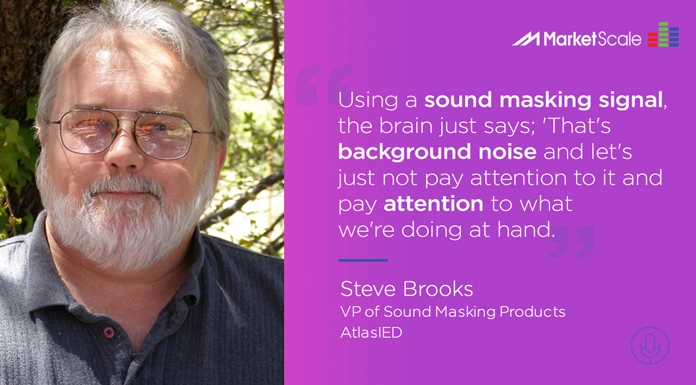The Art and Science of Sound Masking
You may have never heard of sound masking, but the technique has been around since antiquity. Today, the ancient art has been given a digital upgrade and is being applied in corporate spaces to facilitate better conversations and create more comfortable environments. On today’s episode of the MarketScale ProAV podcast, AtlasIED’s Charlie Roy and Steve Brooks fill us in on the sound that, when properly produced, is never heard at all.
“Sound masking or raised ambient background has been around forever,” Charlie says. In fact, the ancient Romans utilized water rushing across raised aquifers to produce pleasant ambient background noise. “All we’re doing today is introducing it artificially, electronically.”
While some people think of sound masking as white or pink noise, it’s neither. “Sound masking contains no information, it’s just broadband shaped noise,” Steve explains. The low-level, electronically generated sound is designed to mask the human voice, making speech unintelligible so you’re not interrupted by other people’s conversations.
 Sound masking is as much art as science. “You don’t want the masking to call attention to itself,” Steve says. But human ears notice bad sound masking as obtrusive background noise that accomplishes the exact opposite of its intention, namely, preventing occupants from concentrating on the task at hand.
Sound masking is as much art as science. “You don’t want the masking to call attention to itself,” Steve says. But human ears notice bad sound masking as obtrusive background noise that accomplishes the exact opposite of its intention, namely, preventing occupants from concentrating on the task at hand.
Charlie reveals that changes in corporate real estate have spurred the need for sound masking solutions. “Traditional office space is going to be replaced, and is being replaced, by open, hard-floor environments due to cost and flexibility.” He points to WeWork as an example, which offers collaborative workspaces that are open and full of reverberant hard surfaces. For these types of buildings, the insertion of masking noise cuts down on distractions, and allows occupants to enjoy a more peaceful environment.
For the latest news, videos, and podcasts in the Pro AV Industry, be sure to subscribe to our industry publication. A new episode of the Pro AV Show drops every Thursday.
Follow us on social media for the latest updates in B2B!
Twitter – @ProAVMKSL
Facebook – facebook.com/marketscale
LinkedIn – linkedin.com/company/marketscale






